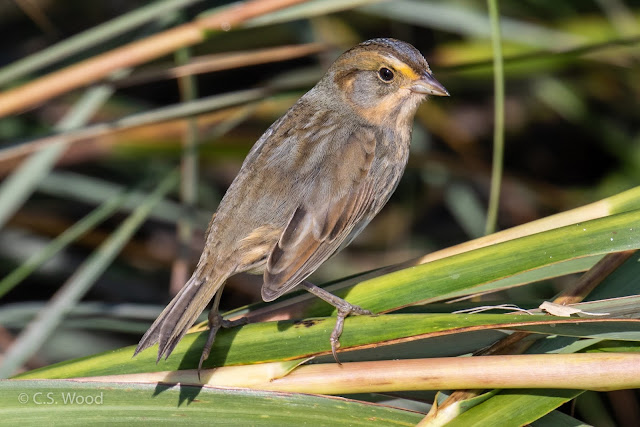Below is my latest contribution to the Connecticut Audubon Society's "Bird Finder" series, emailed to all members.
Once considered a single species, sharp-tailed sparrows are now recognized as two distinct species: Nelson’s and Saltmarsh Sparrows (Nelson’s are named for an early 20th century naturalist who was also Chief of the Bureau of Biological Survey). Although they are similar in appearance, with good looks they are readily distinguished. Key ID features include the sharper black streaking on the breast of the Saltmarsh compared to blurry and fainter streaks on the Nelson’s; darker ochre face coloration on Saltmarsh; and whitish stripes down the Saltmarsh’s back, sometimes characterized as “braces” or “suspenders.” Identification can be complicated somewhat in the Fall as some of the birds may still be molting into prebasic (or “winter”) plumage and the distinctions noted above may be less evident.
Nelson's Sparrow (Ammospiza nelsoni)
Saltmarsh Sparrow (Ammospiza caudacuta)
Only the Saltmarsh Sparrow breeds as far south as Connecticut, where it is being closely studied by UCONN’s Dr. Chris Elphick and his associates, but both can be seen all along Connecticut’s coast during fall migration. The status of the Saltmarsh Sparrow as a breeding species in Connecticut (and elsewhere in its range) is somewhat troubling according to current research looking at the effect of rising sea levels on nesting success, since these birds build nests low in Spartina marshes. For more about this and Dr. Elphick’s research see Saltmarsh Sparrows Fight to Keep Their Heads Above Water from the New York Times (September 17, 2018).
While Saltmarsh Sparrows are restricted - in breeding, migration, and wintering habitat - to tidal salt marshes of the Atlantic coast, Nelson’s Sparrows have three geographically distinct subspecies including one populating inland marshes of central Canada. Saltmarsh Sparrows also exhibit unusual breeding dynamics, with males ranging over large areas mating with many females and females undertaking all of the parental care responsibilities.
© C.S. Wood October 2018
"Sharp-tailed" Sparrows On Fall Migration In Connecticut
I went out to Milford Point though the Connecticut Audubon’s Coastal Center hoping, unsuccessfully it turns out, for better photos of the mega-rarity Roseate Spoonbill that has been reported in recent Bird Finder articles. My consolation was coming across a nice flock of sharp-tailed sparrows in the Spartina marsh along the outer sand dune.
With a nice early morning sun behind me, these pretty little sparrows popped in and out of clumps of tall grasses and even gleaned Spartina seeds from the mud flats literally at my feet. A Marsh Wren harassed any sparrow that invaded its space, and the sparrows themselves did not seem to get along, even though they were obviously “birds of a feather” and flocking together. I’ve tried several times for this photo-op and was finally rewarded, although it was just as much fun observing their antics and feeding behavior.
“Sharp-tailed” Sparrow Identification
Nelson's Sparrow (Ammospiza nelsoni)
Saltmarsh Sparrow (Ammospiza caudacuta)
Status and Conservation
Because of this and other trends, including habitat degradation generally, Saltmarsh Sparrows are considered “Vulnerable” by the IUCN Red List and may be downgraded to “Endangered” according to the Birds of North America Online species account (BNA Online). The Connecticut DEEP Endangered, Threatened and Special Concern Species list identifies Saltmarsh Sparrows as a species of special concern.
Although not afforded the same level of concern, Nelson’s Sparrows face similar habitat and climate challenges. While Maine and a few other states have designated Nelson's Sparrow as a Species of Special Concern, further study of this species is needed, again according to BNA Online.
Where to Find “Sharp-tails”
Although late September through October is the prime time-frame for migratory sharp-tailed sparrows, both species may be seen well into November in Connecticut. One of the best places to look include the aforementioned Connecticut Audubon Coastal Center at Milford Point along the edges of the Spartina alternaflora marsh that encircles the lagoon created by the outer sandbar off the main beach. Hammonassett Beach State Park and marshes near the Town of Guilford boat ramp and the East River State Boat Ramp in Guilford are other good migration sites and Saltmarsh Sparrows nest in these locales as well.
Notable
© C.S. Wood October 2018



Comments
Post a Comment